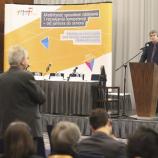On 10 October 2011 dr. Milan Zver was speaking at the conference of the Polish presidency to the EU: Mobility as a tool to acquire and develop competences from childhood to seniority. The conference took place in Sopot, Poland. You may download dr. Zver's speech here:
Youth on the Move - Towards the goals of the Europe 2020 strategy
Conference of the Polish presidency to the EU:
MOBILITY AS A TOOL TO ACQUIRE AND DEVELOP COMPETENCES FROM CHILDHOOD TO SENIORITY
SOPOT, POLAND
17 - 19 October 2011
Dr. Milan Zver
Member of the European Parliament
Committee on Culture and Education
YOUTH ON THE MOVE - TOWARDS THE GOALS OF THE EU 2020 STRATEGY
I. Crises and Youth
Europe is in the midst of a sovereign debt and banking crises, faced with economic stagnation and increasing social insecurity. While trying to prevent Greece from defaulting and some of its major financial institutions from collapsing, to bring back the confidence in the financial markets, Europe should also be working hard on putting in place long-term solutions for reviving its economic growth that will be sustainable and long-lasting. In order to ensure that Europe needs to look after and invest heavily in its young generations, those seem often to be left behind or cut off from the rest of society and statistics seem to prove that over and over again.
Young people are one of the social groups that have been hit hardest by the global financial crisis but at the same time they are not responsible at all for causing it. Therefore Europe should do everything possible to improve their situation, invest and support young people in order for them to be able to secure their own future.
Let me mention some data concerning young people in the EU:
1. At the present moment the youth unemployment rates in the EU are over 20%, which is twice the average of adults. In some Member States youth unemployment rates are over 40%.
2. In total at least 5 million of young Europeans are unemployed.
3. Currently, more than 14% of 18-24 year olds in the EU have finished less than upper secondary education and are not in further education and training.
4. Less than one third of the EU's population has a higher education degree, compared with over 40% in the United States and over 50% in Japan. Europe must increase these numbers in order to be able to make itself more competitive in the global economy. It is estimated that by 2020 35% of all jobs in the EU will require high-level qualifications (compared with 29% today) which amounts to 15 million more jobs.
Before looking at the main ideas and concrete actions proposed by the YoM initiative, I would like to present the main causes for the high unemployment in the EU:
1. Early school leaving (As you know, early school leaving creates risks of young people becoming unemployed and living in poverty, which brings high social and economic costs.)
2. Low basic skills and key competences
3. Insufficient participation in higher education and vocational training
4. Insufficient provision of non-formal learning opportunities for young people
5. Insufficient participation of adults in education and training
6. Insufficient opportunities for the training of education staff and youth workers
7. Low level of entrepreneurship and creativity among young people.
8. The system for recognition and transferability of qualifications is not sufficiently developed.
9. Insufficient cooperation between Schools, Research and Business (Business and research centres do not ensure sufficiently their contribution to the E&T area in order to help them define the education policy and goals).
II. YotM – what is it? A’ spin up’ strategy!
The Youth on the Move initiative has been quite controversial since its very start. Some people thought that it was just another paper and that it will not influence the youth programmes at all.
Others stressed, that this initiative would radically change the youth programmes.
In fact, YotM is a special new strategy that will enhance the implementation of the existing programs and add some practical mechanisms to make youth mobility even more efficient. It is one of seven flagship initiatives within the European Commission's Europe 2020 Strategy to promote smart, sustainable and inclusive economic growth.
YoM consists of 28 key actions and concrete measures to increase the education and training of the youth through mobility and ease the transition of young people from education into the labour market.
It is quite clear that mobility can not be the answer to all the problems of the youth. It will not automatically foster the implementation of goals of the EU Strategy 2020, such as 75% of employment, 40% of population with university degree, reduction drop-out under 10%, fast employability of young people, etc. However, as a spin-up strategy, YotM can do a lot to further improve the situation of the youth. The data show that young people who have attended various forms of learning or working mobility abroad are better at integrating in the society. They are more competitive in the work arena; they participate in the elections more often, which is a sign of higher civic and democratic culture.
What is more, YotM does not offer benefits only to those who actively participate in its activities. It is the ambition of the YotM to further modernise the European school systems and to strengthen the bridge between the school system and the labour market.
It is well known, that the mobility of high quality is key for intercultural learning, personal development and multilingualism of young people. YoM should ensure that these aspects gain due attention and support.
III. Some obstacles to mobility
While the promotion of youth mobility is welcomed, it is essential to overcome practical obstacles, as shown by the Green Paper on Learning Mobility. These include difficulties with visas, medical papers, scholarships when going abroad and additional financial support.
Additionally, it is known that people with disabilities face even more barriers to mobility than others. Of course, students with families should also receive more support.
Despite some mistakes of the Bologna process, it has – no doubt - been positive for young people and their educational needs. The implementation should therefore be continued.
There are many different estimations of what we achieved in the first decade of the reform. Androulla Vassiliou, the new commissioner responsible for the Higher Education, said, that the Bologna Declaration inspired many EU initiatives in higher education and that intensive reforms across all Europe have been seen in the last decade. It is true, she said, that the reform did not fully meet its objectives in all areas, but the European Higher Education Area (EHEA) has become reality! This political assessment is certainly true.
The Bologna reforms were introduced by all EU members, as well as by many others. According to some studies, 95 % of academic institutions managed to establish a two- or three-stage study. 91 % of them modified their study programs.
But louder than the supporters of Bologna reforms are its critics. The charm of the old university among professors and students is still very strong. But, what we need is a new university.
The new type of university, 3GU, as they call it, will have to focus on the production of higher levels of understanding and greater use of knowledge. Inter-disciplinary concept is becoming a hallmark of modern science and replaces the mono-disciplinary, etc, etc.
Modern universities are more open to research and direct transfer of know-how to the economy. Consequently, a permanent dialogue between universities and companies will play a key role in the future. It is estimated that particularly the involvement of universities in economic and development processes and networks is crucial in this the so called third mission of the university, which should become intensely research-oriented in the society. Without this, the European Union will become even less competitive than it is today.
The development of the European Higher Education Area has an important role also in the document of the European Commission Europe 2020 Strategy, which obliges Member States to further reforms in higher education. In the docment prevails the belief that higher quality and in particular the European dimension, which is also one of the objectives of the Bologna reforms, can be achieved through greater mobility.
Labour market does not need only young people with a university degree. Vocational education and training (VET) are also playing an ever increasing role in the successful transition from education to work.
VET is often not given enough attention and something must be done to increase the prestige and recognition of this type of education to attract more young people to it. Additionally, there must be adequate support structures for young VET students studying abroad. The Leonardo da Vinci programme should be increasingly promoted to heighten its visibility and increase participation.
IV. The new strategy for MFF 2014-2020
At the time when I was writing the YoM report for the European Parliament, there was no additional budget allocated for the YoM initiative. All of the 28 concrete YoM actions were supposed to be financed from the already existing budget lines.
In June 2011 the European Commission published its proposal for the new Multiannual financial framework for the period from 2014-2020.
The Commission’s proposals for this period presented an important increase for education and training (+75% including youth and sport) and culture (+37%).
Rationalisation, simplification and ‘EU’ added value are the principles of the budged reform in this field.
Despite many doubts expressed by different stakeholders the European Commission seems to have firmly decided to merge very successful existing programmes into one common programme.
The Education Europe program should receive more than 15 billions of Euros, which is approximately twice as much as the education, mobility and youth programmes receive in the existing financial framework. The European Parliament and all the involved stakeholders warmly greeted this rise.
The structure of the future programme will be built upon three key actions: mobility, cooperation, support of policy reform.
The Commission wants this programme to bring together the currently separate sub-programmes of the Lifelong Learning Programme and the international aspects of Higher Education programmes, including Erasmus Mundus, and Youth in Action. The new programme should allow for greater efficiency, a stronger strategic focus and for synergies to be exploited between the various aspects of the old programmes.
To avoid this new strategy from simply existing as a concept, it is essential that the Member States commit to it both in terms of financial support and its national implementation in their respective countries, and that an EU budget is adopted for it. MS should see this as a long-term investment, not only in young people's education but in the future prosperity of their individual countries and of the EU as a whole.
In addition to funding the YoM actions, it is vital that existing programmes, such as Erasmus, Leonardo da Vinci, Comenius, Grundtvig, Youth in Action and Marie-Curie continue to receive funding and political support.
Ladies and gentlemen, let me conclude with this thought:
Young people are tomorrow's decision-makers, and it is vital that today they are able to develop competences, skills and knowledge that will allow them to actively contribute to sustained future of the European Union.
DOWNLOAD THE SPEECH Youth on the Move - Towards the goals of the Europe 2020 strategy




